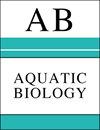土招蟹能量储备的季节和纬度变化:对气候变化的响应
IF 0.8
4区 生物学
Q3 MARINE & FRESHWATER BIOLOGY
引用次数: 10
摘要
2014年,大西洋泥招潮蟹Uca pugnax在其已知的北部活动范围以北80公里处被发现。在此之前的两年,我们从马萨诸塞州的韦勒姆(41.7615°N)到佐治亚州的泰比岛(32.0139°N),沿纬度样带共采集了6个种群的781只雌雄标本。通过评估肝体指数(HSI;(一种储存能量的测量方法)和雌性的生殖状态,我们试图确定成虫的生理和生殖限制是否会减缓北颊狐猴的扩张。我们没有发现HSI的纬度梯度,这表明美国是一个热通才;然而,与北部同种鱼类相比,该范围南部的雄性和雌性的HSI均表现出更大的季节性波动。在整个范围内,雌性的HSI显著降低,揭示了繁殖的成本。2013年5月在马萨诸塞州的收集中发现了雌卵,当时海洋条件还不适合幼虫发育,比以前报道的要早。由于北部地区的成年鲸能够保持与南部同类相当的能量储存,因此北部地区的成年鲸有望密切跟踪西北大西洋的变暖情况,并且它们在早春释放浮游生物幼虫,最大限度地发挥它们的传播潜力。本文章由计算机程序翻译,如有差异,请以英文原文为准。
Seasonal and latitudinal variations in the energy reserves of the mud fiddler crab Uca pugnax: implications for the response to climate change
In 2014, the Atlantic mud fiddler crab Uca pugnax was found 80 km north of its previously known northern range limit. Two years before this shift was noted, we collected a total of 781 male and female specimens from 6 populations along a latitudinal transect extending from Wareham, Massachusetts (41.7615° N), to Tybee Island, Georgia (32.0139° N), USA. By assessing latitudinal and seasonal patterns in the hepatosomatic index (HSI; a measure of stored energy) and the reproductive status of females, we sought to determine whether adult physiological and reproductive limits might slow the northern expansion of U. pugnax. We did not find a latitudinal cline for HSI, suggesting that U. pugnax is a thermal generalist; however, both males and females in the southern part of the range showed greater seasonal fluctuations in HSI compared to northern conspecifics. Across the range, ovigerous females had a significantly reduced HSI, revealing the cost of reproduction. Ovigerous females were found in the May 2013 collection in Massachusetts be fore ocean conditions were permissible for larval development and earlier than previously reported for this species. U. pugnax is expected to closely track warming conditions in the Northwest Atlantic because adults in northern populations are able to maintain energy stores comparable to that of their southern conspecifics, and they release planktonic larvae in early spring, maximizing their dispersal potential.
求助全文
通过发布文献求助,成功后即可免费获取论文全文。
去求助
来源期刊

Aquatic Biology
生物-海洋与淡水生物学
CiteScore
2.70
自引率
0.00%
发文量
7
审稿时长
3 months
期刊介绍:
AB publishes rigorously refereed and carefully selected Feature Articles, Research Articles, Reviews and Notes, as well as Comments/Reply Comments (for details see MEPS 228:1), Theme Sections, Opinion Pieces (previously called ''As I See It'') (for details consult the Guidelines for Authors) concerned with the biology, physiology, biochemistry and genetics (including the ’omics‘) of all aquatic organisms under laboratory and field conditions, and at all levels of organisation and investigation. Areas covered include:
-Biological aspects of biota: Evolution and speciation; life histories; biodiversity, biogeography and phylogeography; population genetics; biological connectedness between marine and freshwater biota; paleobiology of aquatic environments; invasive species.
-Biochemical and physiological aspects of aquatic life; synthesis and conversion of organic matter (mechanisms of auto- and heterotrophy, digestion, respiration, nutrition); thermo-, ion, osmo- and volume-regulation; stress and stress resistance; metabolism and energy budgets; non-genetic and genetic adaptation.
-Species interactions: Environment–organism and organism–organism interrelationships; predation: defenses (physical and chemical); symbioses.
-Molecular biology of aquatic life.
-Behavior: Orientation in space and time; migrations; feeding and reproductive behavior; agonistic behavior.
-Toxicology and water-quality effects on organisms; anthropogenic impacts on aquatic biota (e.g. pollution, fisheries); stream regulation and restoration.
-Theoretical biology: mathematical modelling of biological processes and species interactions.
-Methodology and equipment employed in aquatic biological research; underwater exploration and experimentation.
-Exploitation of aquatic biota: Fisheries; cultivation of aquatic organisms: use, management, protection and conservation of living aquatic resources.
-Reproduction and development in marine, brackish and freshwater organisms
 求助内容:
求助内容: 应助结果提醒方式:
应助结果提醒方式:


